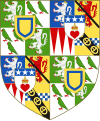Charles Douglas-Home, 13th Earl of Home
The Earl of Home | |
|---|---|
  | |
| Member of the House of Lords Lord Temporal | |
| In office 30 April 1918 – 11 July 1951 Hereditary peerage | |
| Preceded by | The 12th Earl of Home |
| Succeeded by | The 14th Earl of Home |
| Personal details | |
| Born | Charles Cospatrick Archibald Douglas-Home 29 December 1873 |
| Died | 11 July 1951 (aged 77) The Hirsel near Coldstream, Berwickshire, Scotland |
| Nationality | British |
| Spouse | Lady Lillian Lambton (m. 1902) |
| Children | 7, including Sir Alec Douglas-Home |
| Occupation | Banker |
Charles Cospatrick Archibald Douglas-Home, 13th Earl of Home, KT, TD (29 December 1873 – 11 July 1951), styled Lord Dunglass between 1881 and 1918, was a British peer and banker. He served as Lord Lieutenant of Berwickshire from 1930 to 1951. He was the father of a British prime minister, Sir Alec Douglas-Home.
Life and career
[edit]He was born on 29 December 1873, the only son of Charles Douglas-Home, 12th Earl of Home, and Maria Grey, the daughter of Captain Charles Conrad Grey, RN (and great-niece of Charles, 2nd Earl Grey). Styled Lord Dunglass, he was educated at Eton College and at Christ Church, Oxford. He subsequently served as an officer in the 3rd and 4th Battalions, the Cameronians[1][2] and as Colonel in the Lanarkshire Yeomanry and was awarded the Territorial Decoration.[3] He fought in the First World War, where he took part in the Gallipoli Campaign and was mentioned in dispatches. He succeeded to his father's earldom and subsidiary titles on 30 April 1918. He was the Governor of the British Linen Bank from 1930 to 1947. He held the office of Justice of the Peace for Glasgow and Berwickshire, and was a Captain of the Royal Company of Archers. He was invested as a Knight of the Order of the Thistle in 1930. He held the office of Lord Lieutenant of Berwickshire from 1930 until his death. He was awarded the honorary degree of Doctor of Law by the University of Glasgow. He died at his home The Hirsel on 11 July 1951.
Estates
[edit]In 1918, he inherited extensive property and estates from his father, including Douglas Castle, Bothwell Castle, The Hirsel and lands (which totalled some 107,000 acres in 1878) chiefly in Lanarkshire, Roxburghshire and Berwickshire.[4] The following year, he was forced to sell many historic pictures and art treasures from the family collection to settle death duties. Many of the portraits had come from the famous collection of the Earl of Clarendon[5] inherited through Lady Catherine Hyde, daughter of the 4th Earl of Clarendon and wife of the 3rd Duke of Queensberry, and the English and foreign silver was considered to be one of the most important collections to come into the market for some years.[6]
Marriage and children
[edit]On 14 July 1902 at St Margaret's, Westminster, he married Lady Lillian Lambton (8 December 1881 – 26 September 1966), daughter of Frederick Lambton, 4th Earl of Durham.[7] The marriage is held to have been a happy one, and the couple had seven children:
- Alexander Frederick Douglas-Home, 14th Earl of Home, later Baron Home of the Hirsel (1903–1995), Prime Minister of the United Kingdom (1963–1964).
- Lady Bridget Douglas-Home (4 May 1905 – 1980).
- Henry Montagu Douglas-Home (1907–1980), married three times. Firstly, Lady Margaret Spencer, daughter of the 6th Earl Spencer) and had issue, including the journalist Charles Douglas-Home; secondly, Vera Johanson and had issue; thirdly, Felicity Jonsson and had issue.
- Lady Rachel Douglas-Home (10 April 1910 – 4 April 1996), married Lord William Walter Montagu-Douglas-Scott and had issue.
- William Douglas-Home (1912–1992), married Rachel Douglas-Home, 27th Baroness Dacre and had issue.
- Edward Charles Douglas-Home (1 March 1920 – 17 February 2006), married Nancy Straker-Smith and had issue.
- George Cospatrick Douglas-Home (1922–14 June 1943), killed on active service as a Pilot Officer in the RAF, unmarried.
References
[edit]- ^ Hesilrige 1921, p. 482.
- ^ "No. 27439". The London Gazette. 3 June 1902. p. 3611.
- ^ The Peerage, retrieved 10 January 2016
- ^ John Bateman (1878), The Great Land Owners of Great Britain and Ireland, London, Harrison and Sons
- ^ Catalogue of portraits in the Collection of the Earl of Clarendon, Robin Gibson, Paul Mellon Centre for Studies in British Art, 1977
- ^ The Times, London, 13 July 1951, page 6, obituary
- ^ "Court Circular". The Times. No. 36820. London. 15 July 1902. p. 10.
Work cited
[edit]- Hesilrige, Arthur G. M. (1921). Debrett's Peerage and Titles of courtesy. 160A, Fleet street, London, UK: Dean & Son. p. 482.
{{cite book}}: CS1 maint: location (link)
